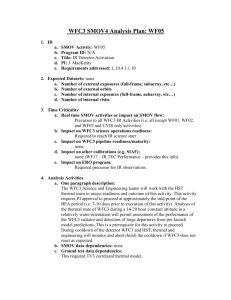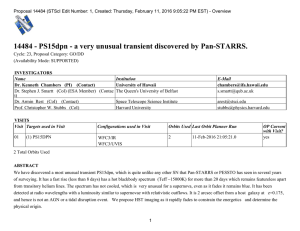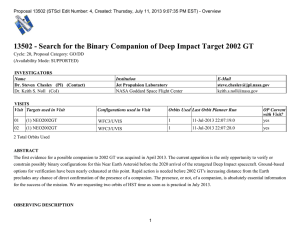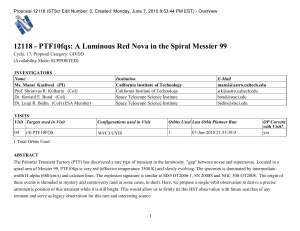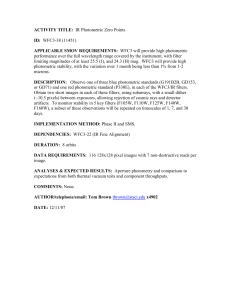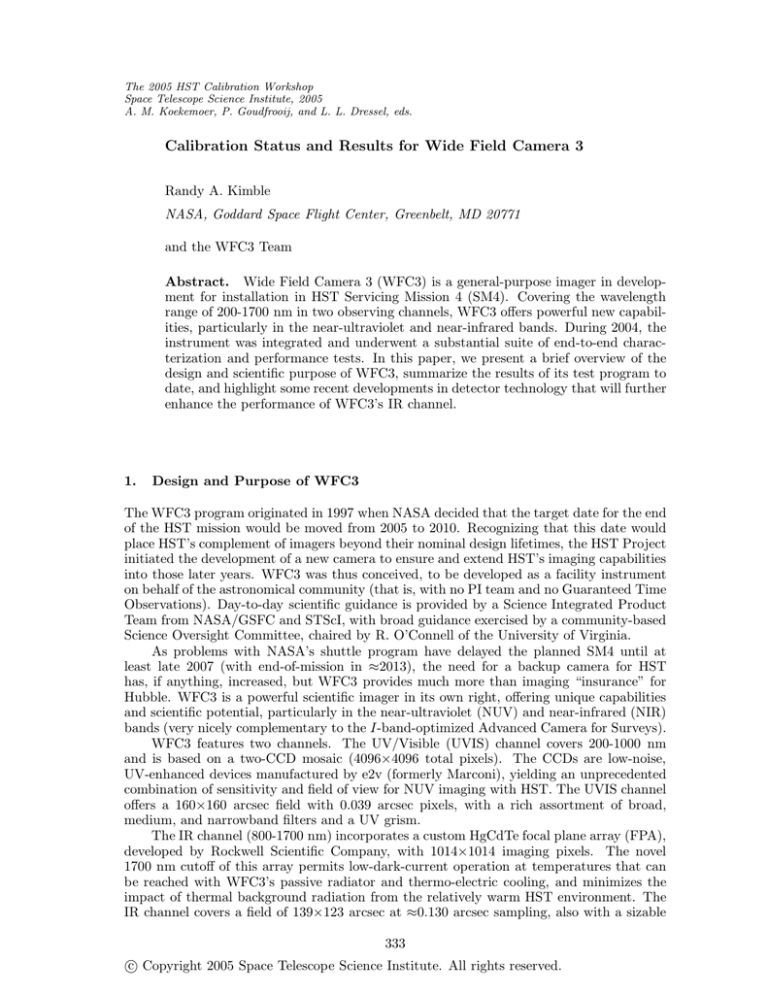
The 2005 HST Calibration Workshop
Space Telescope Science Institute, 2005
A. M. Koekemoer, P. Goudfrooij, and L. L. Dressel, eds.
Calibration Status and Results for Wide Field Camera 3
Randy A. Kimble
NASA, Goddard Space Flight Center, Greenbelt, MD 20771
and the WFC3 Team
Abstract. Wide Field Camera 3 (WFC3) is a general-purpose imager in development for installation in HST Servicing Mission 4 (SM4). Covering the wavelength
range of 200-1700 nm in two observing channels, WFC3 offers powerful new capabilities, particularly in the near-ultraviolet and near-infrared bands. During 2004, the
instrument was integrated and underwent a substantial suite of end-to-end characterization and performance tests. In this paper, we present a brief overview of the
design and scientific purpose of WFC3, summarize the results of its test program to
date, and highlight some recent developments in detector technology that will further
enhance the performance of WFC3’s IR channel.
1.
Design and Purpose of WFC3
The WFC3 program originated in 1997 when NASA decided that the target date for the end
of the HST mission would be moved from 2005 to 2010. Recognizing that this date would
place HST’s complement of imagers beyond their nominal design lifetimes, the HST Project
initiated the development of a new camera to ensure and extend HST’s imaging capabilities
into those later years. WFC3 was thus conceived, to be developed as a facility instrument
on behalf of the astronomical community (that is, with no PI team and no Guaranteed Time
Observations). Day-to-day scientific guidance is provided by a Science Integrated Product
Team from NASA/GSFC and STScI, with broad guidance exercised by a community-based
Science Oversight Committee, chaired by R. O’Connell of the University of Virginia.
As problems with NASA’s shuttle program have delayed the planned SM4 until at
least late 2007 (with end-of-mission in ≈2013), the need for a backup camera for HST
has, if anything, increased, but WFC3 provides much more than imaging “insurance” for
Hubble. WFC3 is a powerful scientific imager in its own right, offering unique capabilities
and scientific potential, particularly in the near-ultraviolet (NUV) and near-infrared (NIR)
bands (very nicely complementary to the I-band-optimized Advanced Camera for Surveys).
WFC3 features two channels. The UV/Visible (UVIS) channel covers 200-1000 nm
and is based on a two-CCD mosaic (4096×4096 total pixels). The CCDs are low-noise,
UV-enhanced devices manufactured by e2v (formerly Marconi), yielding an unprecedented
combination of sensitivity and field of view for NUV imaging with HST. The UVIS channel
offers a 160×160 arcsec field with 0.039 arcsec pixels, with a rich assortment of broad,
medium, and narrowband filters and a UV grism.
The IR channel (800-1700 nm) incorporates a custom HgCdTe focal plane array (FPA),
developed by Rockwell Scientific Company, with 1014×1014 imaging pixels. The novel
1700 nm cutoff of this array permits low-dark-current operation at temperatures that can
be reached with WFC3’s passive radiator and thermo-electric cooling, and minimizes the
impact of thermal background radiation from the relatively warm HST environment. The
IR channel covers a field of 139×123 arcsec at ≈0.130 arcsec sampling, also with a sizable
333
c Copyright 2005 Space Telescope Science Institute. All rights reserved.
334
Kimble & WFC3 Team
Figure 1: Schematic diagram of WFC3. Significant elements (radiator, enclosure, UVIS
filter mechanism) are re-used WF/PC-1 hardware, while the electronics have substantial
heritage from STIS, NICMOS, and ACS.
Figure 2: Optical layout of WFC3. The WFC3 pickoff mirror captures the on-axis beam
from HST, which is then directed (as the shaded light beams in the figure indicate) to either
the UVIS or IR channel, depending on the position of the Channel Select Mechanism.
Calibration Status and Results for Wide Field Camera 3
335
Figure 3: Schematic diagrams of the field of view (FOV) of the WFC3 UVIS (left) and
IR (right) channels, compared with the FOV of current HST instruments. Note the large
size of the UVIS FOV compared with those of the other HST imagers offering high NUV
sensitivity (the STIS NUV and ACS HRC channels) and the dramatic increase in IR FOV
vs. the largest field NICMOS camera.
complement of filters and grisms. The improved detector sensitivity and dramatic increase
in field of view vs. NICMOS result in a major advance in NIR imaging for HST.
WFC3 is intended for installation into the radial instrument bay currently occupied
by WFPC2 (see Figures 1 and 2 for schematic diagrams of the instrument’s configuration).
The dramatic advances in field of view (FOV) offered by WFC3 for NUV and NIR imaging
are shown schematically in Figure 3. Coupling the FOV increases with the high sensitivity
of the instrument at these wavelengths, WFC3 will enable a rich program of scientific
observations. The UVIS channel will be particularly well suited to the study of the star
formation history in nearby galaxies (by virtue of the high sensitivity of NUV observations
to the age of stellar populations) and the chemical enrichment history of galaxies, and to
the search for Ly α dropouts in the problematic redshift range of z = 1 − 2. The NUV
portion of the UVIS bandpass will also probe one of the darkest spectral regions of the
natural sky background, permitting the detection of very low surface brightness objects.
The IR channel will take advantage of the dark IR sky in space to study: Type Ia
supernovae and the accelerating universe, galaxy formation at high redshifts, and the sources
of cosmic re-ionization. The penetrating power of IR observations will be brought to bear
on the dust-enshrouded processes of star formation, and the IR channel will also enable new
studies of water and ices in our own solar system.
In short, WFC3 is a powerful new instrument, offering unique capabilities for astronomical observing. See Kimble, MacKenty, & O’Connell (2004) for additional details regarding
the WFC3 design and scientific potential.
2.
Highlights of Ambient and Thermal-Vacuum Testing
As is well known, there was a period throughout 2004 during which SM4 was officially cancelled on the grounds of shuttle safety. Currently, as directed by the NASA Administrator,
the HST program is back to working toward a shuttle-based SM4, nominally scheduled for
December 2007; a formal decision to execute the mission will not be made, however, until
successful return-to-flight for the shuttle program.
336
Kimble & WFC3 Team
Figure 4: Photo of WFC3, integrated in preparation for its thermal-vacuum performance
characterization test in late 2004.
Fortunately, the WFC3 program was not directed to stop work during 2004. Instead,
the team was permitted to continue integration of the instrument (see Figure 4) toward
execution of a “performance demonstration” thermal-vacuum test (with the idea that after
demonstration of the capabilities of WFC3, it could potentially be made available for a
non-HST launch opportunity). Though this meant that some issues that would normally
be dealt with during instrument integration were deferred (and added to a “lien list” to be
resolved now that the program has returned to a prepare-for-flight status), it enabled WFC3
to carry out an early and invaluable end-to-end evaluation of the instrument’s performance.
The performance characterization thermal-vacuum test was carried out in AugustOctober 2004 (with significant ambient testing of the UVIS channel performed before that
time). Though the goals of the tests were not to produce a full scientific calibration, all
aspects of WFC3 were investigated, with very satisfactory results overall. We highlight
some of the key results here, in Tables 1 and 2 and Figures 5-8; additional details regarding
the thermal-vacuum test program are presented by Bushouse et al. (2006) in this volume.
Table 1: Key UVIS Channel Thermal-Vacuum Results.
Characteristic
Dark current
Read noise (rms)
Linearity
Encircled energy
Cal system
Filter ghosts
Specification; Goal
e− /pix/hour
<20
<4 e− /pix; <3 e− /pix
<5% deviation over 100-50,000 e−
250nm: >0.75; >0.80 in 0.00 20
633nm: >0.75; >0.80 in 0.00 25
10,000 e− /pix in <10 min
Uniform to <2×
<0.2% of incident in a ghost
Measured
0.2-0.4 e− /pix/hour
2.98-3.08 e− /pix
<3% deviation
250nm: 0.78-0.81
633nm: 0.77-0.81
<1 min
≈7×
up to 15% for a small
subset of filters (see text)
Calibration Status and Results for Wide Field Camera 3
337
Table 2: Key IR Channel Thermal-Vacuum Results.
Characteristic
Dark current
Read noise (rms)
(CDS pair of images)
Full well
Encircled energy
(1000nm)
Encircled energy
(1600nm)
Cal system
Filter ghosts
a
CEI spec; goal
e− /pix/s;
Measured
e− /pix/s
<0.4
<0.1
−
<15 e /pix; <10 e− /pix
0.1 e− /pix/s
≈23 e− /pix
>100,000 e− /pix; >150,000 e− /pix
>0.56; >0.61 in 0.00 25
>0.72; >0.80 in 0.00 37
>0.48; >0.54 in 0.00 25
>0.75; >0.80 in 0.00 60
10,000 e− /pix in <10 min
Uniform to <2×
<0.2% of incident in a ghost
≈100,000 e− /pix
0.52-0.56a
0.73-0.77
0.40-0.44a
0.77-0.81
<1 min
≈25×
<0.2%
The measured encircled energies require small corrections for the difference in central obscuration between the
ground test aberrated beam simulator vs. the real HST Optical Telescope Assembly; with those corrections,
the measured encircled energies are in line with the requirements (see Figure 5).
The detector performance in end-to-end thermal-vacuum testing summarized in Tables
1 and 2 is in complete agreement with the results of testing at the device and sub-system
level: the UVIS CCDs show a low read noise of 3 e− rms (the lowest of any HST CCD camera) and negligible dark current; the IR detectors were known to have higher-than-specified
read noise, but the very low dark current vs. specifications and the measured throughput
of the optical system bring the overall sensitivity of the channel within specification.
Optical performance is excellent (Figure 5), with many encircled energy results well
exceeding specifications; slight departures seen in the IR channel are likely the result of a
small amount of detector interpixel diffusion.
The throughput of the UVIS channel is in close agreement with pre-test predictions
(based on individual component measurements) throughout the visible, and (delightfully)
well exceeds those predictions in the NUV range, where our early CCD calibrations had
underestimated the sensitivity of the UV-enhanced devices (the NUV test setup has since
been improved). In the IR, the end-to-end throughput runs systematically 10-15% below
component-based predictions across the band. This discrepancy is a bit beyond the expected
error bars in the comparison, so the team is investigating to see whether there is a correctable
source for the discrepancy. In any case, the measured end-to-end throughput in thermalvacuum testing confirms the dramatic discovery potential for WFC3 in both the NUV and
NIR bands; see Figure 8 for a tantalizing comparison of WFC3 vs. other HST instruments.
The most noteworthy performance discrepancies shown in the tables are the severe
ghosting exhibited by a small subset of the UVIS filter set and poor performance of the
internal calibration subsystem at this stage of integration. The filter ghosting issue is
described in detail by Baggett et al. (2006) in this volume; to summarize briefly, we have
procured greatly improved replacements for all high-priority filters with out-of-spec ghost
intensities. The Scientific Oversight Committee has confirmed the acceptability of these
replacements and the replacement process is in work. For the calibration subsystem, the
UVIS channel simply requires improved alignment, while the IR channel flat-field nonuniformity will be rectified by replacing one of the transfer lenses in the calibration path.
Overall the thermal-vacuum characterization program was extremely successful and
provides invaluable guidance in the team’s ongoing preparation of the instrument for flight.
338
Kimble & WFC3 Team
Figure 5: (left) Encircled energy vs. radius for UVIS channel images. (right) Encircled
energy vs. radius for IR channel images. Phase-retrieval measurements of the delivered
wavefront confirm the high quality of the optical system. Encircled energy results in the IR
channel are likely affected by a small amount of interpixel diffusion in the detector.
UVIS CLEAR throughput
Throughput (absolute w/q-yield cor.)
0.5
0.4
0.3
0.2
0.1
CHIP 1
CHIP 2
0.0
200
400
600
Wavelength (nm)
800
1000
Figure 6: Unfiltered throughput (detected photons/input photons) for the UVIS channel;
representative values are shown for each of the CCDs. The actual signal detected at short
wavelengths (in electrons/input photon) is higher than shown here due to CCD quantum
yield, which exceeds one electron per detected photon below ≈340nm. The curves shown
here have been corrected for that effect.
339
Calibration Status and Results for Wide Field Camera 3
IR filtered throughput
0.6
Q3 2004 Sep 19 (dropped 930 nm)
Q3 2004 Sep 22 (abbreviated run)
Q3 2004 Sep 29 (clean run)
Q1 2004 Oct 3 (dropped 1640 nm)
Q3 2004 Oct 3 (abbreviated run)
Throughput (absolute)
0.5
0.4
0.3
0.2
1000
1200
1400
Wavelength (nm)
F167N
F164N
F160W
F153M
F139M
F130N
F132N
F125W
F126N
F127M
F128N
F110W
F105W
F098M
0.0
F093W
0.1
1600
Figure 7: Throughput of IR channel as measured in thermal-vacuum test, including filters.
The overall slope vs. wavelength is dominated by the detector quantum efficiency.
ACS/WFC
Throughput x Area (arcsec2)
10000
WFC3/IR (new)
WFC3/UVIS
WFC3/IR (old)
WFPC2
1000
NICMOS/NIC3
ACS/HRC
100
200
300
400 500
700
1000
Wavelength (nm)
2000
Figure 8: Comparative discovery efficiencies of various HST imagers. The discovery efficiency is defined as the throughput of the instrument (detected photons/input photons)
× the area of the instrument’s field of view. The curves are generated by calculating this
quantity, including the filter transmission, at the center of band for the different broadband
filters available for each instrument. For the WFC3/IR channel, the dashed curve (old)
is based on the end-to-end throughput measured in the thermal-vacuum testing described
above; the solid curve (new) scales up the throughput to the higher quantum efficiencies offered by new IR detectors that are currently in fabrication for flight (see Section 3). WFC3’s
uniquely powerful capabilities in the NUV and NIR bands are evident.
340
3.
Kimble & WFC3 Team
Improved Detectors for the IR Channel
In the course of development of WFC3, radiation testing of the IR detector arrays revealed
an unexpected phenomenon. When exposed to a high-energy proton beam in the ground
radiation test, the detector images showed a significant diffuse signal between the direct
proton hits (Figure 9 - left). Further testing isolated the source of the diffuse signal to
the thick CdZnTe substrate on which the HgCdTe detection layer is grown (Waczynski et
al. 2005); when hit by high-energy particles, the substrate appears to produce luminescent
output that is then detected by the HgCdTe layer.
Without a detailed understanding of the physical mechanism, scaling from the laboratory test conditions to the orbital radiation environment, and from one FPA to another, is
uncertain. Our best estimate, however, is that the background produced in orbit by cosmic
rays from this effect could be comparable to the intrinsic dark current of the devices, thus
lowering the faint-target sensitivity of the IR channel if the effect is not eliminated.
Fortunately, in the time since our current flight FPA was acquired, Rockwell Scientific
Company has successfully developed a process for removing the CdZnTe substrate after
hybridizing the HgCdTe arrays. WFC3 radiation tests confirm that substrate removal
completely eliminates the radiation-induced background phenomenon (Figure 9 - right).
Hence, substrate-removed lots of WFC3 IR arrays are currently being procured, with the
intention of packaging a new FPA for flight and removing the radiation risk.
Of even greater benefit, the substrate-removed FPAs show extremely high quantum
efficiency (QE) across the WFC3 IR band, greatly improved over the performance of the
current WFC3 flight device, FPA64 (Figure 10). (FPA64 was in the instrument for the
thermal-vacuum testing described above.) The performance observed for the new devices
appears to cluster in two groups: one with relatively flat QE across the WFC3 IR band,
and one with more sloped QE, but both offering marked improvement over FPA64.
The new devices do have one drawback. So far, the substrate-removed devices produced
for WFC3 exhibit higher dark current tails than seen in FPA64 (Figure 11). Interestingly,
there is a clear correlation that the group of detectors with high, flat QE curves shows
systematically larger dark current tails than the lower QE group.
Additional cooling of the detector produces marked dark current benefits. Our thermalvacuum test demonstrated good thermal performance margin, so we can confidently project
that the IR FPA can be operated at least down to 145K vs. the previous operating point
of 150K. This 5 degree shift drops the dark current by more than a factor of two and
significantly reduces the fraction of pixels in the dark current tail (Figure 12).
Fabrication of additional devices from the substrate-removed lots is ongoing, and Rockwell believes that small adjustments in the substrate-removal process for the remaining parts
will yield better combinations of QE and dark current performance. However, we demonstrate below that even the currently available devices offer markedly improved scientific
performance for WFC3 vs. FPA64, even neglecting that detector’s radiation vulnerability.
In Table 3, we show a metric of “survey speed” in different filter bands, for several
candidate WFC3 detectors (cf. Robberto et al. 2005). This metric is defined as the product
of the speed (i.e. 1/exposure time required) to reach a given faint target magnitude in
the given filter band × the area of the IR channel’s field of view. The metric is then
normalized so that the value for the NIC3 camera of NICMOS (the widest field imager of
that instrument) is equal to 1.
The metric is tabulated for the J & H bands (F110W and F160W, respectively) and
a representative narrow-band filter (F126N). The values for FPA64 demonstrate the orderof-magnitude increase in survey speed over NICMOS previously touted for the WFC3 IR
channel (with our measured end-to-end throughputs). For each of the devices, we tabulate
the mean dark rate for a particular percentage of the pixels, and we then scale the effective
FOV for WFC3 by that percentage to account for the effects on surveying efficiency of
masking the hot pixel tails.
Calibration Status and Results for Wide Field Camera 3
341
Figure 9: Radiation test results for WFC3 IR detectors. (left) cut across irradiated image
for FPA with CdZnTe substrate, showing diffuse signal between the discrete hits; (right)
analogous image cut for substrate-removed FPA, showing elimination of luminescence effect.
Figure 10: (left) Strikingly high QEs for group of substrate-removed IR FPAs, compared
with QE of current flight detector, FPA 64. (right) QEs of other group of substrate-removed
FPAs; less QE improvement, but better dark current performance than devices at left.
Figure 11: Cumulative dark current histograms for the two groups of detectors and current
flight device, FPA64. At each value of dark current, the quantity plotted is the percentage
of pixels with dark current exceeding that value. The group of substrate-removed devices
with higher QE also exhibits a higher percentage of pixels in a high dark current tail.
342
Kimble & WFC3 Team
Figure 12: Cumulative Dark Current Histograms at 145K Operating Temperature
The results show that even a conservative choice of substrate-removed detector, such
as FPA112 or FPA116 (with little or no hot pixel masking required), offers noticeable
performance benefits over FPA64. The best high-QE parts (FPAs 104 and 105) offer more
dramatically improved survey efficiency, though with greater complexity in observing (more
dithering) and calibration to deal with the higher hot pixel percentages. Finally, the last
line of the table shows the superb performance of a detector offering an “ideal” combination
of parameters: 90% QE across the band along with low dark tail and read noise.
Table 3: Survey Speed Metric for Candidate IR Detectors.
Detector
CDS Noise
Mean Dark (145K)
F110W
F160W
F126N
FPA64
FPA112
FPA116
FPA104
FPA105
24
24
29
33
28
0.04 (100%)
0.09 (100%)
0.18 (98%)
0.14 (90%)
0.10 (90%)
12.5
15.6
20.0
28.7
26.6
9.1
7.7
7.4
10.4
10.0
11.7
12.4
13.0
18.2
20.6
Potential FPA?
20
0.04 (100%)
31.4
12.5
36.1
In conclusion, WFC3 will be a scientifically powerful addition to the HST suite of
instruments. The WFC3 team looks forward to completing the instrument and providing
this new capability to the astronomical community.
References
Baggett, S. et al., 2006, The 2005 HST Calibration Workshop. Eds. A. M. Koekemoer, P.
Goudfrooij, & L. L. Dressel, this volume, 348
Bushouse, H. et al.,2006, The 2005 HST Calibration Workshop. Eds. A. M. Koekemoer, P.
Goudfrooij, & L. L. Dressel, this volume, 343
Kimble, R. A., MacKenty, J. W., & O’Connell, R. W. 2004, Proc. SPIE, 5487, 266
Robberto, M. et al. 2005 in Scientific Detectors for Astronomy, eds. P. Amico & J. W.
Beletic (Dordrecht: Springer), in press
Waczynski, A. et al. 2005, Proc. SPIE, 5902, 161



